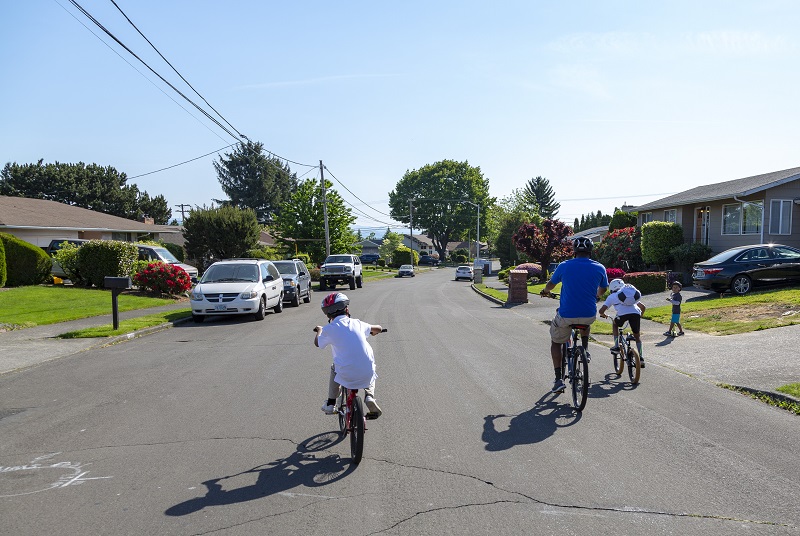
Contributing authors: Margo Pedroso, Marisa Jones, Michelle Lieberman, Kari Schlosshauer, Demi Espinoza, and Cass Isidro
With COVID-19 closing gyms and many parks and trails, people are looking for ways to get outside, to safely exercise, or to use the street when there aren’t as many cars. Given the increased volume of users in trails and parks that remain open and that many sidewalks are too narrow for walking while socially distanced, some communities and organizations are pushing local leaders to limit car traffic on low-volume streets while social distancing orders are in effect to create more physical distance for walking, biking and rolling.
However, in the regions where our staff work closely on the ground, there are concerns about some ways this is being rolled out around the country, which we share and wanted to elevate. Any campaign to urge local leaders to create space on streets must be approached thoughtfully, with an understanding of the local community’s specific needs.
We have included below some questions that advocates should consider when pursuing a campaign to create space on streets for recreation. Many of these questions are ultimately about solutions your local government should implement, but before launching a public push, we hope you will consider talking with your local agencies to better understand if a healthy streets effort is feasible in your community.
We encourage communities to consider a “Healthy Streets”-type campaign (thanks to Seattle for the name), guaranteeing first that essential jobs, grocery stores, and other critical destinations are accessible by biking, walking, and transit, and then ensuring that people in all neighborhoods have safe places to be outside and for physical activity. While physical distancing orders are still in effect, it’s also important to remember and reinforce that staying home saves lives.
1. Equity: Have people and groups across the community been consulted to determine the right solutions for each neighborhood? Did that consultation go beyond engagement that requires Internet access (for example, through radio, phone calls, flyers, or pop-ups at essential services) and is the outreach being done in multiple languages? Another solution is to engage with trusted organizations, associations, or groups that are active in key neighborhoods or with key demographics to get their input. If that engagement has happened and healthy streets are a priority for residents, make sure that healthy streets or routes are prioritized based on their proximity to low-income communities and communities of color, and in areas lacking yards, parks, and other green space.
2. Necessity and basic needs before recreation: Before looking to create space in the streets for recreation, are the immediate transportation necessities and basic needs already addressed? For example, can streets be prioritized with extra space near grocery stores, and community food or school lunch pick-up areas where people need more space to safely wait to access food? Can street space be allocated for walk-through testing for COVID-19 to serve residents without a vehicle? Have temporary or permanent wider sidewalks and bike lanes already been established to help essential workers get between home and work while maintaining safe distances, and to provide walking and biking access to transit hubs? If none of these are currently being addressed, can your campaign focus on broader uses of the street to include these critical needs as well as recreation?
3. Resources: Does the local government have the resources (thinking both about staff time and funding) to create space in the streets for recreation without diverting them from critical needs, such as maintaining core transit, walking, and biking routes needed for essential workers to get to their jobs and for deliveries to continue; ensuring transit workers have essential personal protective equipment; or providing safe access and meals to schoolchildren and community food pickup locations? Many local governments are seeing their revenue decline while expenses related to the pandemic climb.
4. Enforcement: Can the street changes be made without increasing police and enforcement? Communities of color must be involved in, or better still – leading, these discussions to ensure any closures are done in a way that is safe and welcoming for everyone. For example, can traffic control barriers be used instead of police cars and police officers?
If healthy streets campaigns are put forward with focus and compassion during this time of crisis, we can ensure we support local agencies as they work to address immediate needs while also building support for increasing space for walking and biking in the future. We value recreation and the ability to get outside; connections to nature and the outdoors are important for both mental and physical health. However, we need to be cautious in this time of crisis that immediate needs are prioritized, and that any campaigns don’t have the unintended side effect of increasing transmission of COVID-19 or limiting transportation needs for others, especially for communities most affected by the pandemic.
Learn More
The League of American Bicyclists is hosting a webinar on Thursday, April 30 from 2:00 - 3:00 p.m. ET on adapting streets to COVID-19. Attendees will hear from advocates who have worked with their communities to adapt streets to provide more space for people biking and walking. Register here.
Other Blog Posts in This Series
- Equitable Community Engagement in the Time of Social Distancing
- Financial Help for Nonprofits During COVID-19
- Active Transportation Advocates as Allies: What Bike/Ped/Safe Routes to School Advocates Can Do to Support Other Pressing Issues During COVID-19
- Advocating for Active Transportation in the Time of COVID-19
- Safe Routes to School and Beyond: What to Do Now?
- During Social Distancing We Need Safe and Accessible Parks
